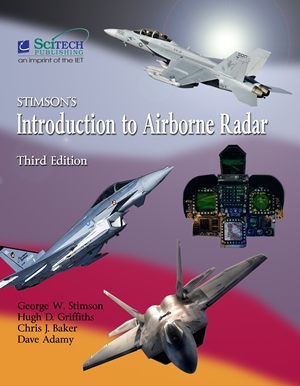- Agricultural Engineering and Technology
- Applied Physics
- Built Environment
- Computing and Networks
- Control, Robotics and Sensors
- Electrical Regulations
- Electromagnetics and Radar
- Energy Engineering
- Healthcare Technologies
- History and Management of Technology
- IET Codes and Guidance
- Manufacturing
- Materials, Circuits and Devices
- Model Forms
- Security
- Telecommunications
- Transportation
In stock

Stimson's Introduction to Airborne Radar, 3rd Edition
by George W. Stimson
Edited by Hugh D. Griffiths, Christopher J. Baker, Dave Adamy
Completely modernized, greatly expanded, but retaining all the magic of the 2nd edition, Introduction to Airborne Radar has been brought into the 21st century without losing the hallmarks that made George Stimson's previous editions unique. Every chapter has been updated to reflect the constant transformations in radar technology and end-of-chapter exercises have also been added, improving its employment as a textbook.
Over 100 radar and EW experts from around the world were involved in reviewing, writing, and editing this book, each one a longtime user of the previous editions. Each one of them was tasked with making sure this third edition lives up to its legacy of 'Introduction.'
Stimson's is written specifically as an overview without going overboard on the math. Virtually anyone with a knowledge of high school algebra, trigonometry, and physics will be able to read and absorb the vast majority of the material. The first 17 chapters provide fundamentals that can be used by air, ground, and sea-based personnel. Every chapter provides extensive fundamental materials and practical applications, using visual system exemplars to aid explanations. The unique full color layout is enhanced with an immense number of illustrations, figures, tables, and color photographs.
Key features:
- Modernized to reflect changes in the past 20 years including electronic scanning antennas and high resolution imaging.
- Completely covers the wide range of techniques employed in modern airborne and space borne radars.
- Fundamentals are applicable to ground and sea-based radar.
- Clear, understandable writing supplemented by extensive graphic illustration of concepts and offset boxes taking those concepts to the next level.
- Community reviewed by over 100 radar experts from organizations worldwide.
About the Author
George W. Stimson was the author of Introduction to Airborne Radar (1st and 2nd editions) and served as an engineer on Southern California Edison's frequency-change project before being hired by Hughes Aircraft Company. Working closely with the company's top designers, Stimson observed first-hand the fascinating evolution of airborne radar and with the help from Hughes engineers updated the first edition with 11 new chapters.
About the Editors
Hugh D. Griffiths holds the Thales/Royal Academy of Engineering Chair of RF Sensors within the Department of Electronic and Electrical Engineering at University College London. He has received numerous awards, served as President of the IEEE AESS Society for 2012/13, is a member of the IEEE AESS Radar Systems Panel, and is Editor-in-Chief of the Journal IET Radar, Sonar and Navigation.
Chris J. Baker is the Ohio State Research Scholar in Integrated Sensor Systems at The Ohio State University. He has been actively engaged in radar systems research since 1984 and is the author of over 250 publications. His research covers coherent radar techniques, radar signal processing, radar signal interpretation, electronically scanned radar systems, radar imaging, natural and cognitive echo locating systems. He has won numerous awards for research and holds visiting position at a number of the worlds leading universities.
Dave Adamy is an internationally recognized expert in electronic warfare with 47 years experience as a systems engineer. He has published over 180 articles, has 11 books in print and is a past National President of the Association of Old Crows. For the past 26 years he has run his own company performing studies for the United States Government and defense contractors as well as teaching EW courses worldwide.
Publication Year: 2014
Pages: 774
ISBN-13: 978-1-61353-022-1
Format: HBK
Editors: Hugh D. Griffiths, Christopher J. Baker, Dave Adamy
